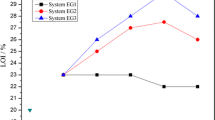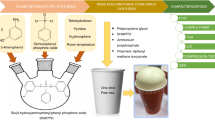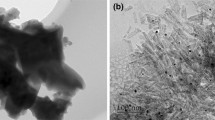Abstract
Expanded polystyrene (EPS) foams were flame retarded using ammonium polyphosphate (APP) and nano-zirconia (nano-ZrO2) by means of phenolic resin as a binder. It is found that the incorporation of a small amount (5 phr) of nano-ZrO2 into the APP flame-retarded EPS foams leads to 19% increase in flexural strength and 38% increase in compressive strength. Flame-retardant properties of the flame-retarded EPS foams were investigated by limiting oxygen index (LOI), UL-94 and cone calorimetry test (CCT). The LOI of the APP flame-retarded EPS foams in presence of nano-ZrO2 is above 31%, and the UL 94 V-0 rating can be reached. The CCT test results indicate that the APP flame-retarded EPS foams containing nano-ZrO2 have lower peak heat release rate, average effective heat of combustion and average specific extinction area. Moreover, thermal decomposition of the flame-retarded EPS foams was investigated by thermogravimetric analysis (TGA) and the TGA results illustrated clearly that the addition of nano-ZrO2 into the APP flame-retarded EPS foams leads to an increase in the residual char yield. The reason for the increase is possibly because ZrO2 may react during combustion process with pyrophosphoric acid produced from the thermal decomposition of APP to form zirconium pyrophosphate (ZrP2O7) confirmed by XRD studies of the char, which is helpful to improve the formation of the char. The XPS results showed that the ratio of oxidized carbons in the char increases with the presence of nano-ZrO2.







Similar content being viewed by others
References
Wang JQ, Chow WK (2005) A brief review on fire retardants for polymeric foams. J Appl Polym Sci 97:366–376
Doroudiani S, Omidian H (2010) Environmental, health and safety concerns of decorative mouldings made of expanded polystyrene in buildings. Build Environ 45:647–654
Levchik SV, Wei ED (2008) New developments in flame retardancy of styrene thermoplastics and foams. Polym Int 57:431–448
Covaci A, Gerecke AC, Law RJ, Voorspoels S, Kohler M, Heeb NV, Leslie H, Allchin CR, de Boer J (2006) Hexabromocyclododecanes (HBCDs) in the environment and humans: a review. Environ Sci Technol 40:3679–3688
Messer A (2010) Mini-review: polybrominated diphenyl ether (PBDE) flame retardants as potential autism risk factors. Physiol Behav 100:245–249
Kandola BK, Krishnan L, Ebdon JR (2014) Blends of unsaturated polyester and phenolic resins for application as fire-resistant matrices in fibre-reinforced composites: effects of added flame retardants. Polym Degrad Stabil 106:129–137
Hong YF, Fang XD, Yao DG (2015) Processing of composite polystyrene foam with a honeycomb structure. Polym Eng Sci 55:1494–1503
Hu LF, Wang ZZ (2015) Flame retardant and mechanical properties of expanded polystyrene foams containing aluminum phosphinate and expandable graphite. In: Chen S, Zhou S (eds) Proc Int Conf Adv Energy, Environ Chem Eng, vol. 23, AER-Adv Eng Res, pp 223–226
Chen X, Liu Y, Bai SB, Wang Q (2014) Macromolecular nitrogen-phosphorous compound/expandable graphite synchronous expansion flame retardant polystyrene foam. Polym Plast Technol Eng 53:1402–1407
Abadchi MR, Jalali-Arani A (2015) Synergistic effects of nano-scale polybutadiene rubber powder (PBRP) and nanoclay on the structure, dynamic mechanical and thermal properties of polypropylene (PP). Iran Polym J 24:805–813
Wang WT, Zhang H, Dai YY, Hou HX, Dong HZ (2015) Effects of various nanomaterials on the properties of starch/poly(vinyl alcohol) composite films formed by blow extrusion process. Iran Polym J 24:687–696
Morgan AB, Harris RH, Kashiwagi T, Chyall LJ, Gilman JW (2002) Flammability of polystyrene layered silicate (clay) nanocomposites: carbonaceous char formation. Fire Mater 26:247–253
Wang XL, Wu LH, Li J (2011) Synergistic flame retarded poly(methyl methacrylate) by nano-ZrO2 and triphenylphosphate. J Thermal Anal Calorim 103:741–746
Cinausero N, Azema N, Lopez-Cuesta JM, Cochez M, Ferriol M (2011) Synergistic effect between hydrophobic oxide nanoparticles and ammonium polyphosphate on fire properties of poly(methyl methacrylate) and polystyrene. Polym Degrad Stab 96:1445–1454
Lu HD, Wilkie CA (2010) Study on intumescent flame retarded polystyrene composites with improved flame retardancy. Polym Degrad Stab 95:2388–2395
Ciecierska E, Jurczyk-Kowalska M, Bazarnik P, Gloc M, Kulesza M, Kowalski M, Krauze S, Lewandowska M (2016) Flammability, mechanical properties and structure of rigid polyurethane foams with different types of carbon reinforcing materials. Compos Struct 140:67–76
Javni I, Song K, Lin J, Petrovic ZS (2011) Structure and properties of flexible polyurethane foams with nano- and micro-fillers. J Cell Plast 47:357–372
Song SA, Chung YS, Kim SS (2014) The mechanical and thermal characteristics of phenolic foams reinforced with carbon nanoparticles. Compos Sci Technol 103:85–93
Xu QF, Chen LZ, Harries KA, Zhang FW, Liu Q, Feng JH (2015) Combustion and charring properties of five common constructional wood species from cone calorimeter tests. Construct Build Mater 96:416–427
Ma YF, Wang JF, Xu YZ, Wang CP, Chu FX (2013) Preparation and characterization of phenolic foams with eco-friendly halogen-free flame retardant. J Thermal Anal Calorim 114:1143–1151
Wu ZP, Shu WY, Hu YC (2007) Synergist flame retarding effect of ultrafine zinc borate on LDPE/IFR system. J Appl Polym Sci 103:3667–3674
Gu JW, Zhang GC, Dong SL, Zhang QY, Kong J (2007) Study on preparation and fire-retardant mechanism analysis of intumescent flame-retardant coatings. Surf Coat Technol 201:7835–7841
Takabayashi S, Motomitsu K, Takahagi T, Terayama A, Okamoto K, Nakatani T (2007) Qualitative analysis of a diamondlike carbon film by angle-resolved X-ray photoelectron spectroscopy. J Appl Phys 101:103542
Takabayashi S, Okamoto K, Shimada K, Motomitsu K, Motoyama H, Nakatani T, Sakaue H, Suzuki H, Takahagi T (2008) Chemical structural analysis of diamondlike carbon films with different electrical resistivities by X-ray photoelectron spectroscopy. Jpn J Appl Phys 47:3376–3379
Li GX, Yang JF, He TS, Wu YH, Liang GZ (2008) An investigation of the thermal degradation of the intumescent coating containing MoO3 and Fe2O3. Surf Coat Technol 202:3121–3128
Ko TH, Kuo WS, Chang YH (2001) Microstructural changes of phenolic resin during pyrolysis. J Appl Polym Sci 81:1084–1089
Acknowledgements
This work was financially supported by the National Natural Science Foundation of China (No. U1205114).
Author information
Authors and Affiliations
Corresponding author
Rights and permissions
About this article
Cite this article
Wang, Z., Jiang, S. & Sun, H. Expanded polystyrene foams containing ammonium polyphosphate and nano-zirconia with improved flame retardancy and mechanical properties. Iran Polym J 26, 71–79 (2017). https://doi.org/10.1007/s13726-016-0499-4
Received:
Accepted:
Published:
Issue Date:
DOI: https://doi.org/10.1007/s13726-016-0499-4




